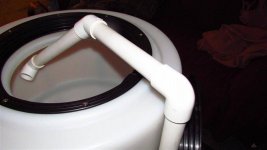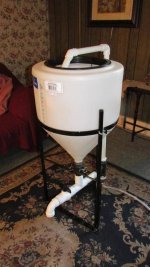You are using an out of date browser. It may not display this or other websites correctly.
You should upgrade or use an alternative browser.
You should upgrade or use an alternative browser.
10 min $10 DIY aerated compost tea ACT brewer
- Thread starter heady blunts
- Start date
hey jerry,
im in the back woods too and cant find rock dust locally either... i found a 50 pound bag online but it'll cost 35 bucks to ship. thats why i'm considering azomite... same website has that in small jugs and isn't nearly as expensive to ship.
groworganic.com has everything we need if you can get past the shipping.
If you guys live anywhere near farmers there is likely a supply store that will have soft rock phosphate.
StrapAssassin42
Member
thanks MM... gona check Fleet Farm.
S
SeaMaiden
I read a paper that hinted that there's little actual benefit to be gained from glacial rock dust (though I do have it in my arsenal), and I personally don't know that it's a good corollary for soft (or colloidal) rock phosphate in any event. Try looking for colloidal phosphate, see if that nets you results (seems to go by different names).The only reason I am asking is because i am having a very hard time finding "Glacial Rock Dust" in Maine.
Obviously if this wont fit the bill, then I wont use it. I was just wondering and weighing my options.
Any comments are greatly appreciated!
jerry.
I read a paper that hinted that there's little actual benefit to be gained from glacial rock dust (though I do have it in my arsenal), and I personally don't know that it's a good corollary for soft (or colloidal) rock phosphate in any event. Try looking for colloidal phosphate, see if that nets you results (seems to go by different names).
was this study done in a organic soil? tested to be full of life? without the proper microbes rock dusts aint going to do diddly squat.
I read a paper that hinted that there's little actual benefit to be gained from glacial rock dust (though I do have it in my arsenal), and I personally don't know that it's a good corollary for soft (or colloidal) rock phosphate in any event. Try looking for colloidal phosphate, see if that nets you results (seems to go by different names).
Good advice
J
jerry111165
I'll get there - and of course thanks for all the input.
heres just another thought...Up here in the northeast we seem to pretty much have drilled artesian wells - mine is 400' deep drilled thru the bedrock , down into the aquifer. Whenever I see a well being drilled, there is always a stone "paste" - very fine, almost to the point of talc consistency, stone powder around the drill hole.
I'm probably talking out my butt - just wondering. I know somebody who drills wells. The dust/paste is super fine.
just a thought.
jerry.
heres just another thought...Up here in the northeast we seem to pretty much have drilled artesian wells - mine is 400' deep drilled thru the bedrock , down into the aquifer. Whenever I see a well being drilled, there is always a stone "paste" - very fine, almost to the point of talc consistency, stone powder around the drill hole.
I'm probably talking out my butt - just wondering. I know somebody who drills wells. The dust/paste is super fine.
just a thought.
jerry.
S
SeaMaiden
We got so much of that finely ground rock from our well (not artesian, requires... 1/2hp pump IIRC) that it created a new partially level area under the old black oak. The drilling company stacked up some bales of straw and pumped the effluent there, and it's still there, sunken in remarkably little consider that was in '05.
That stuff was damn near like talc, it was a trip, never seen anything like it (never lived on a well) before.
Jay, I am currently drawing such a complete blank on that paper that I can't even recall if they were calling it glacial rock dust or green something.
That stuff was damn near like talc, it was a trip, never seen anything like it (never lived on a well) before.
Jay, I am currently drawing such a complete blank on that paper that I can't even recall if they were calling it glacial rock dust or green something.
I'll get there - and of course thanks for all the input.
heres just another thought...Up here in the northeast we seem to pretty much have drilled artesian wells - mine is 400' deep drilled thru the bedrock , down into the aquifer. Whenever I see a well being drilled, there is always a stone "paste" - very fine, almost to the point of talc consistency, stone powder around the drill hole.
I'm probably talking out my butt - just wondering. I know somebody who drills wells. The dust/paste is super fine.
just a thought.
jerry.
That could be driller's mud which is bentonite clay, some great to use, some not, depending on heavy metal analysis.
Jerry111
I'd like your permission to use your brewer photo(s) to illustrate that a vortex can be created using only one riser/return pipe. I asked some other members as well. I would PM you but I don't think you have enough posts yet.
I'd like your permission to use your brewer photo(s) to illustrate that a vortex can be created using only one riser/return pipe. I asked some other members as well. I would PM you but I don't think you have enough posts yet.
J
jerry111165
Jerry111
I'd like your permission to use your brewer photo(s) to illustrate that a vortex can be created using only one riser/return pipe. I asked some other members as well. I would PM you but I don't think you have enough posts yet.
Of course you can - but I apologize for the bad picture(s). The one showing the circulation was actually taken with my Blackberry... it is kind of blurry.
Use it for now, but the next time I run the brewer I will get a better one for you with my good camera. Here are 2 just showing the tank shape at least, and the direction of the return pipe - which is of course pretty important as far as starting the vortex.
With the cone shape of the tank, I dont have to do anything but turn on the air pump - the vortex is created immediately and automatically.
SeaMaiden - thanks for your input on the stone dust. I'm always looking for all the info I can get!
Attachments
Thankyou Jerry
Of course you can - but I apologize for the bad picture(s). The one showing the circulation was actually taken with my Blackberry... it is kind of blurry.
Use it for now, but the next time I run the brewer I will get a better one for you with my good camera. Here are 2 just showing the tank shape at least, and the direction of the return pipe - which is of course pretty important as far as starting the vortex.
With the cone shape of the tank, I dont have to do anything but turn on the air pump - the vortex is created immediately and automatically.
SeaMaiden - thanks for your input on the stone dust. I'm always looking for all the info I can get!
Your living room looks like mine except mine has
 girls
girlsOne more thing. You guys who said I could use your photos don't mind if I refer to you as 'my children' huh? ;>
Long term, slow-release feeding, Rock Phosphate becomes naturally available as the plant needs it. Plant roots give off carbon dioxide and certain organic acids which react with the rock phosphate in the soil, making it available for plant use. Because Espoma® Rock Phosphate is ground, a sufficient part of it is almost immediately available to the plant because the organic acids and carbon dioxide produced by the plant roots and bacteria in the soil can break it down quickly.
hrmmm

One more thing. You guys who said I could use your photos don't mind if I refer to you as 'my children' huh? ;>
i was going to suggest disciples lol

Hehe
StrapAssassin42
Member
Hey fellas...
I'm going to build the brewer featued @ the start of this thread.
What advantage do i get out of the vortex action vs. the straight drop like the one in in Microbeman's pic?
thanks for any input.
I'm going to build the brewer featued @ the start of this thread.
What advantage do i get out of the vortex action vs. the straight drop like the one in in Microbeman's pic?
thanks for any input.
One more thing. You guys who said I could use your photos don't mind if I refer to you as 'my children' huh? ;>
I was thinking my picture would have the caption, "my bitches", so I guess "my children" is a little better.
 I can tell you that you alone have taught me more about organics than any book I have read so far. Thank you father Microbeman.
I can tell you that you alone have taught me more about organics than any book I have read so far. Thank you father Microbeman.



